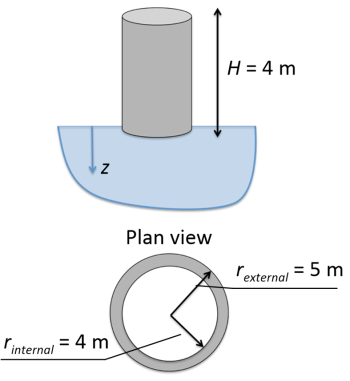Example 3.1
Stresses in soil due to a water tank founded on a ring-type foundation
An H = 4 m tall water tank with radius rexternal = 5 m is going to be founded on a ring foundation, with the dimensions depicted in the following plan view. Assuming the tank is filled with water, determine the vertical stress due to the weight of the tank below the centre of the foundation, at a depth z = 5 m.

Answer:
First we have to determine the maximum load, Qext on the foundation, assuming that the tank is filled with water:
Atank = πrexternal2 = 78.54 m2
Qext = A × H × yw = 78.54 m2 x 4 m x 10 kN/m3 = 3141 kN where 10 kN/m3 is the unit weight of water.
The area of the ring footing on which the load is applied is:
Afooting= πrexternal2 – πrinternal2 =78.54 m2-50.26 m2 = 28.28 m2
thus the pressure applied on the ring foundation of the tank will be:
qext = Qext/Afooting = 111 kPa
Employing the principle of superposition discussed in Chapter 3.5, this ring pressure is equivalent, in terms of stresses applied to the soil, to a circular pressure qext,1 = 111 kPa on a radius rexternal = 5 m, plus a circular pressure qext,2 = -111 kPa on a radius rinternal = 4 m (see also Figure 3.14). Negative pressure values correspond to tension. The additional vertical stress in the soil below the axis of symmetry of a circular pressure is provided by Eq. 3.13. At depth z = 5 m, the positive pressure of radius rexternal = 5 m will result in a compressive stress:
![Rendered by QuickLaTeX.com \Delta {\sigma _{z,ext}} = {q_{ext,1}}\left[ {1 - {{\left( {\dfrac{1}{{1 + {{\left( {\dfrac{{{r_{external}}}}{z}} \right)}^2}}}} \right)}^{\frac{3}{2}}}} \right] = 111\left[ {1 - {{\left( {\dfrac{1}{{1 + {{\left( {\tfrac{5}{5}} \right)}^2}}}} \right)}^{\frac{3}{2}}}} \right] = 71.75{\rm{ \:kPa}}](https://oercollective.caul.edu.au/app/uploads/quicklatex/quicklatex.com-600280c987798bfe67e25cb80eb00a9c_l3.png)
while the negative pressure of radius rinternal = 4 m in a tensile stress:
![Rendered by QuickLaTeX.com \Delta {\sigma _{z,{\mathop{\rm int}} }} = {q_{ext,2}}\left[ {1 - {{\left( {\dfrac{1}{{1 + {{\left( {\dfrac{{{r_{{\mathop{\rm internal}}}}}}{z}} \right)}^2}}}} \right)}^{\frac{3}{2}}}} \right] = - 111\left[ {1 - {{\left( {\tfrac{1}{{1 + {{\left( {\tfrac{4}{5}} \right)}^2}}}} \right)}^{\frac{3}{2}}}} \right] = - 58.15{\rm{ \: kPa}}](https://oercollective.caul.edu.au/app/uploads/quicklatex/quicklatex.com-48fb09c443e55a03c39c9b5bd3d3d246_l3.png)
The total stress increment due to the loading applied on the ring foundation is found from Eq. 3.21 as:
![]()

